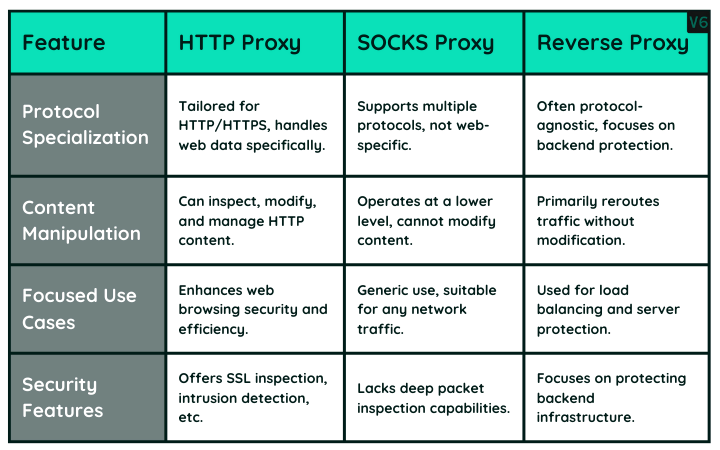“What are HTTP proxies?” This question often arises as users navigate the complexities of the web. HTTP proxies are more than just technical tools; they are gatekeepers that enhance connectivity, protect data, and let you do more online.
This guide discusses the essence and operations of HTTP proxies, exploring their functions, protocols, and the multiple use cases that make them an indispensable tool in network management and cybersecurity.
Starting with a foundational overview, we explain “What are HTTP proxies?” and discuss how they distinguish themselves from other proxy types. We further dissect the HTTP proxy protocol, outlining its specifications and authentication methods. As we progress, we detail the workings of HTTP proxies, including request handling, connection management, and performance optimization through caching.
Table of Contents
What Is An HTTP Proxy?
An HTTP proxy specifically handles Hypertext Transfer Protocol (HTTP) communications between a client and the internet. This type of proxy is designed to interpret, process, and manage web traffic, enabling enhanced functionalities like request modification, content filtering, and data caching tailored to HTTP requests.
In essence, an HTTP proxy means a server that intermediates requests and responses between a user’s device and the web server, exclusively for HTTP and HTTPS traffic. It uses its position to cache data, accelerate load times, enforce security policies, and anonymize user IP addresses, among other benefits.
How Is An HTTP Proxy Different From Other Proxy Types?
An HTTP proxy is a specialized type of proxy server that is designed specifically to handle web (HTTP) traffic. It differs from other proxy types in several key ways:
- Protocol Specialization: HTTP proxies are tailored for the HTTP and HTTPS protocols, which are the backbones of web browsing and data transfers on the internet. This contrasts with SOCKS proxies, which handle a variety of protocols but lack the capability to interpret or modify web content.
- Content Manipulation: These proxies have the ability to inspect, modify, and manage HTTP content. They can alter HTTP headers and manage cookies, which enables functionalities like ad-blocking, website restriction, and session management. Generic proxies like SOCKS do not offer these capabilities as they operate at a lower level of the network stack.
- Focused Use Cases: HTTP proxies primarily enhance user security and efficiency when browsing the web. They are effective for implementing content filters, enforcing corporate and school internet usage policies, and providing geo-spoofing capabilities. This is different from reverse proxies, which are used mainly for load balancing and protecting servers from direct external access.
- Advanced Security Features: Due to their deep understanding of web traffic, HTTP proxies offer advanced security features such as SSL inspection, intrusion detection, and detailed logging and reporting, which are beyond the capabilities of more basic proxies.
HTTP proxies are the preferred choice for web-related tasks.

What Is The Difference Between HTTP and HTTPS Proxies?
The key difference between HTTP and HTTPS proxies lies in how they handle data security:
- HTTP Proxy: An HTTP proxy interacts with HTTP traffic without encrypting it. This type of proxy is faster but less secure, as the data remains unencrypted, making it susceptible to interception and eavesdropping.
- HTTPS Proxy: Conversely, an HTTPS proxy handles traffic that is encrypted by the HTTPS protocol, providing a secure channel. This type of proxy ensures that the data exchanged between the client and the server is encrypted and secure from potential interceptors.
Behind the Scenes: How HTTP Proxies Work
Now let’s go deeper and explore the unseen part of HTTP proxies – the mechanics of their functionality and how they help make your web interactions smoother:
- Request and Response Handling: HTTP proxies intercept client requests and forward them to the intended server. They then receive the server’s response and relay it back to the client. During this process, proxies can modify headers or filter content based on predefined rules.
- Connection Management: These proxies manage connections by establishing a persistent connection to the server, which reduces the overhead of establishing a new connection for each request. This is especially beneficial in environments where multiple requests are made to the same server.
- Caching and Performance Optimization: HTTP proxies improve loading times and reduce bandwidth usage by caching frequently requested resources. They store copies of web pages, images, and other content, serving this cached data to users when the same requests are made, thereby speeding up the response time and conserving network resources.
Main HTTP Proxy Server Use Cases
HTTP proxy servers serve multiple roles, addressing both performance and security needs across various settings. Here’s a closer look at some of the primary applications:
- Web Browsing and Content Filtering: HTTP proxies provide a robust platform for managing and filtering internet content. Schools, workplaces, and governments use them to block access to inappropriate websites and to monitor and control internet usage.
- Web Scraping and Data Extraction: They are instrumental for data scraping from various websites, allowing businesses to collect and analyze large amounts of data efficiently and anonymously. Learn all about that use case in our web scraping proxy service guide.
- Bypassing Geo-restrictions and Censorship: HTTP proxies enable users to access content and services that are geographically restricted or censored by appearing to be in a different location.
- Load Balancing and Traffic Management: These proxies can distribute network traffic across multiple servers, enhancing the performance of web applications by balancing the load, which reduces server strain and optimizes resource utilization.
- Security and Privacy Considerations: HTTP proxies enhance security by encrypting requests and masking users’ IP addresses, thereby safeguarding personal information and mitigating the risk of cyber attacks.
Answers To Practical Questions You Ask
The following are some frequently asked questions related to HTTP proxies and how to use them in various scenarios:
What Is HTTP Proxy For WiFi?
An HTTP proxy can be used with Wi-Fi networks to provide an additional layer of security and privacy when connecting to the internet. By routing your web traffic through the proxy server, your actual IP address is masked, making it harder for websites or potential attackers on the same network to track your online activities or identify your device.
What Is The HTTP Proxy On iPhone And iPad?
The HTTP proxy settings on iOS devices like iPhones and iPads ,allow you to configure a proxy server to route your web traffic through. This can be useful for bypassing content restrictions, accessing geo-blocked websites, or enhancing online privacy while using your iOS mobile device.
How To Use HTTP Proxy Injector?
HTTP proxy injectors are tools or browser extensions that allow you to easily enable or disable proxy settings for specific websites or applications. They can automatically inject the proxy configuration into your browser or app, simplifying the process of using different proxies for different use cases.
Should HTTP Proxy Be On Or Off On Android?
Whether an HTTP proxy should be turned on or off depends on your specific needs and use case. If you require enhanced privacy, content filtering, or access to restricted websites, then enabling the HTTP proxy on Android can be beneficial. However, if you don’t have any particular need for a proxy and prefer direct internet access, it’s generally recommended to keep the HTTP proxy turned off.
How To Set HTTP_PROXY Environment Variable In Windows?
To set the HTTP_PROXY environment variable in Windows, follow these steps:
- Access Environment Variables: Right-click ‘This PC’ or ‘Computer’ on the desktop or in File Explorer, select ‘Properties’, then click ‘Advanced system settings’. Alternatively, directly search for “Edit the system environment variables” in the Start menu.
- System Properties: In the System Properties window, click on the “Environment Variables” button to open the environment variables configuration.
- Modify or Add Variable: Scroll through the “System Variables” section to locate HTTP_PROXY. If it is not listed, click “New” to create it. You should also consider adding HTTPS_PROXY and NO_PROXY variables if needed for your network setup.
- Set the Variable: Enter HTTP_PROXY in the variable name field, and set the variable value in the format http://proxy.example.com:8080, where “proxy.example.com” and “8080” should be replaced with your actual proxy address and port number.
- Apply and Restart: Click “OK” to save the changes. Remember that you may need to restart any command prompts or applications to apply these new settings.
After setting the HTTP_PROXY environment variable, any applications or tools that reference this variable will use the specified proxy server for HTTP traffic.
How To Know If You Need An HTTP Proxy For Docker?
If you’re running Docker containers that need to access the internet or communicate with external services, you may need to configure an HTTP proxy. This is particularly important if your Docker host is behind a corporate firewall or has restricted internet access. Without an HTTP proxy, your containers may not be able to download dependencies, update packages, or communicate with external APIs.
How To Use HTTP-Proxy-Middleware?
The http-proxy-middleware is a Node.js module that can be used to proxy HTTP requests in a Node.js application. To use it, you first need to install the module using npm or yarn. Then, in your application code, you can import the module and create a proxy middleware instance, specifying the target server or URL to proxy requests to. Finally, you can add this middleware to your Express.js app or connect it to a specific route.
How To Use HTTP-Proxy-Middleware In React?
To use the http-proxy-middleware in a React application, you typically set it up during the development server configuration. In a Create React App project, you can modify the package.json file and add the http-proxy-middleware configuration under the proxy key. Specify the target URL or server you want to proxy requests to, and the middleware will automatically handle proxying requests during development.
What is The Difference Between SOCKS5 And HTTP Proxy?
SOCKS5 and HTTP proxies are different types of proxy servers with distinct characteristics:
| SOCKS5 Proxy | HTTP Proxy |
| Supports various protocols (HTTP, HTTPS, FTP, etc.). | Specifically designed for HTTP(S) traffic. |
| Operates at the network layer, handling all types of network traffic without data inspection. | Operates at the application layer, capable of inspecting, modifying, and caching HTTP data. |
| Generally faster for non-web traffic due to its protocol-agnostic nature. | Optimized for web traffic with features like content filtering, caching, and compression. |
| May require client-side software and can be more complex to set up. | Easier to configure in web browsers and operating systems for web-specific tasks. |
How To Check HTTP Proxy In Linux?
To check the HTTP proxy settings in Linux, you can use various methods depending on your distribution and desktop environment. Here are a few common ways:
- Command Line: Open a terminal and run the following command to check the HTTP_PROXY environment variable: echo $HTTP_PROXY
- System Settings: Many Linux distributions provide a graphical interface to manage network and proxy settings. For example, in Ubuntu, you can go to System Settings > Network > Network Proxy to view and modify proxy settings.
- Browser Settings: Most web browsers allow you to configure proxy settings within their preferences or options menu. Check the network or proxy settings in your browser to see if an HTTP proxy is set.
- Configuration Files: Some applications and system services read proxy settings from configuration files like /etc/environment or ~/.bashrc. You can open these files and look for lines setting the HTTP_PROXY variable.
If an HTTP proxy is configured, you should see the proxy server address and port number displayed in the output or settings. If no proxy is set, the output or settings should be empty or show a default value.
Main Takeways
- HTTP proxies mediate HTTP communications between clients and the internet, handling web traffic and data management.
- Unlike SOCKS proxies that handle various protocols, HTTP proxies specialize in HTTP/HTTPS, enabling content manipulation and enhanced web traffic management.
- HTTP proxies boost web browsing efficiency by caching data, managing connections, and optimizing performance for high request environments.
- HTTP proxies are adjustable on various devices and settings, enhancing privacy, security, and network traffic management for web applications and Docker containers.
Related articles:




